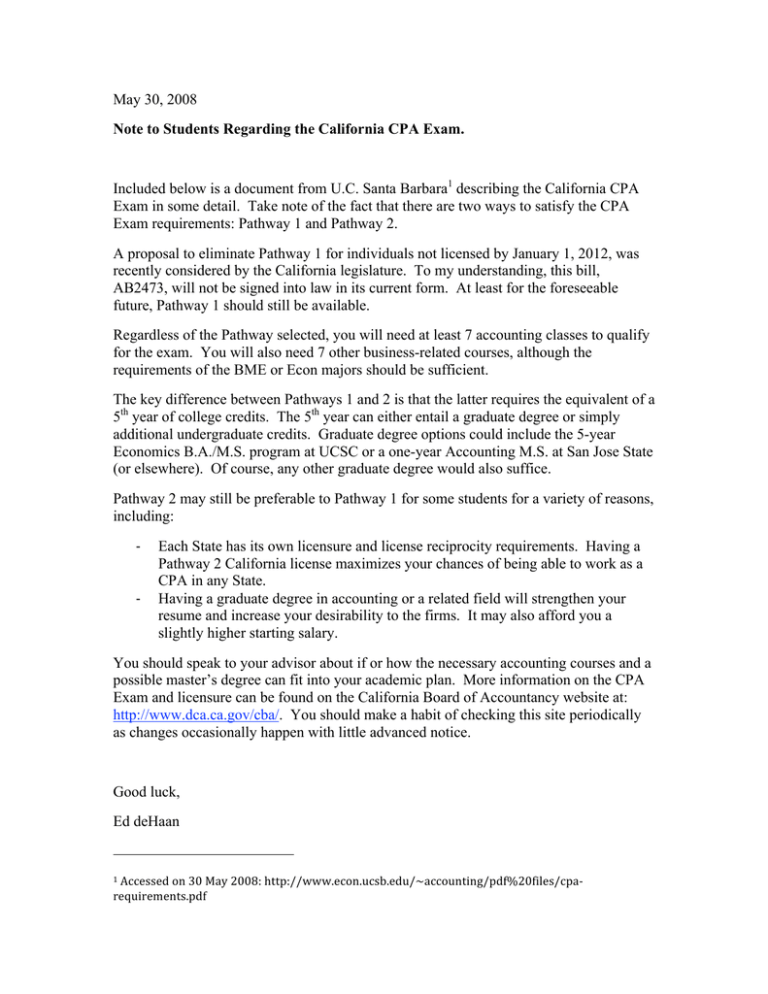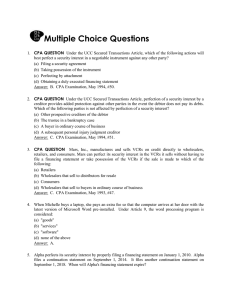May 30, 2008 describing the California CPA
advertisement

May 30, 2008 Note to Students Regarding the California CPA Exam. Included below is a document from U.C. Santa Barbara1 describing the California CPA Exam in some detail. Take note of the fact that there are two ways to satisfy the CPA Exam requirements: Pathway 1 and Pathway 2. A proposal to eliminate Pathway 1 for individuals not licensed by January 1, 2012, was recently considered by the California legislature. To my understanding, this bill, AB2473, will not be signed into law in its current form. At least for the foreseeable future, Pathway 1 should still be available. Regardless of the Pathway selected, you will need at least 7 accounting classes to qualify for the exam. You will also need 7 other business-related courses, although the requirements of the BME or Econ majors should be sufficient. The key difference between Pathways 1 and 2 is that the latter requires the equivalent of a 5th year of college credits. The 5th year can either entail a graduate degree or simply additional undergraduate credits. Graduate degree options could include the 5-year Economics B.A./M.S. program at UCSC or a one-year Accounting M.S. at San Jose State (or elsewhere). Of course, any other graduate degree would also suffice. Pathway 2 may still be preferable to Pathway 1 for some students for a variety of reasons, including: ! ! Each State has its own licensure and license reciprocity requirements. Having a Pathway 2 California license maximizes your chances of being able to work as a CPA in any State. Having a graduate degree in accounting or a related field will strengthen your resume and increase your desirability to the firms. It may also afford you a slightly higher starting salary. You should speak to your advisor about if or how the necessary accounting courses and a possible master’s degree can fit into your academic plan. More information on the CPA Exam and licensure can be found on the California Board of Accountancy website at: http://www.dca.ca.gov/cba/. You should make a habit of checking this site periodically as changes occasionally happen with little advanced notice. Good luck, Ed deHaan """""""""""""""""""""""""""""""""""""""""""""""""""""""" #"$%%&''&(")*"+,"-./"0,,12"34452667778&%)*89%':8&(96;.%%)9*4<*=65(>?0,><@&'6%5.! A&B9<A&C&*4'85(>" GENERAL CPA EXAM INFORMATION Certified Public Accountant The Certified Public Accountant (CPA) designation is a license issued by one of the 54 states or territories of the United States that authorizes the holder to practice as a certified public accountant in that jurisdiction. Licensing of CPAs helps to protect the public because only those individuals who have met prescribed requirements are permitted to hold themselves out to the public as certified public accountants. The public is therefore protected from substandard work performed by individuals who do not meet the minimum requirements specified by the boards of accountancy. Uniform CPA Examination The Uniform Certified Public Accountant (CPA) Examination is offered on computer at a network of test centers across the United States and its territories. Based on a recent study of the work performed by newly licensed CPAs, the computerbased CPA Examination incorporates increased emphasis on information technology and general business knowledge with a broadened scope in the audit area. Significantly, changes include increased skills testing; for example, research and analytical skills. By staying aligned with the expanding “real-world” requirements of entry-level CPA work, and required testing skills, the revised CPA Examination helps ensure an uninterrupted examination process that continues to protect the public interest. The new Uniform CPA Examination is a 14-hour test with four sections: Auditing and Attestation; Financial Accounting and Reporting; Regulation; and Business Environment and Concepts. The examination is still one of the requirements for licensure by the 54 states and territories (jurisdictions) of the United States. In order to take the examination, you must be declared eligible by one of the jurisdictions. Each jurisdiction sets its own requirements for education, examination and experience. To become certified in the State of California, applicants must meet the requirement set forth by the California State Board of Accountancy. A complete list of requirements and exam application information can be found on the Boards web site at http://www.dca.ca.gov/cba/. Exam information is also available on the Accounting Program web site at http://www.econ.ucsb.edu/~accounting. CPA Exam Educational Requirements To take the exam in California applicants must meet the following educational requirements: • • • Baccalaureate degree. 36 quarter (24 semester) units of accounting. 36 quarter (24 semester) units of business-related subjects. Students completing Business Economics with an Emphasis in Accounting will have met these requirements. 1 When applying for licensure in California, applicants select Pathway 1 or Pathway 2. At that time, applicants must demonstrate they meet the exam education requirements, passed the exam, and meet the licensure education and experience requirements for their chosen Pathway. The requirements are: LICENSURE Pathway 1 Pathway 2 Education Requirement • Baccalaureate degree. • 36 quarter units of accounting. • 36 quarter units of businessrelated subjects. • Baccalaureate degree. • 36 quarter units of accounting. • 36 quarter units of businessrelated subjects. PLUS • Total of 225 quarter units. Experience Requirement • Two years of general experience, under the supervision of a CPA. • One year of general experience, under the supervision of a CPA. For those students seeking employment with the Big Four or looking to practice in another state, it is recommended they meet the requirements of Pathway 2. Since the requirements to practice as a CPA are determined by each state, Pathway 2 is designed to meet the requirements in other states that require a fifth year of education (225 units). Pathway 2 allows applicants to practice in other states without completing any additional education or exam requirements. The 225 units do not have to be completed to take the exam. Review for the CPA Exam The UCSB Professional Preparation Program for Accounting through the UCSB extension program is designed to help students review for the exam and meet the new California requirements for CPA licensure by providing an additional 24 units (four courses at six units each) to help students meet the 225 unit requirement of Pathway 2. The program is conducted over ten weeks and is designed for students to take during the summer following their senior year. Topics include: advanced auditing and attestation, current issues in financial reporting, regulatory framework of business, and special topics in accounting. For more information, visit http://www.econ.ucsb.edu/~accounting/index, call (805) 893-8957, or email Richard Watson Ph.D. at watson@econ.ucsb.edu. Roger Phillip offers a CPA review year round with live or on-line classes. Demonstration classes available on-line. For more information, please call 877-ROG4CPA or go to the web site www.RogerCPAreview.com. Beckersconvisor also offers a CPA review course in-class, online, or on CD-Rom. Becker also offers an Exam Cram, a one-day intense review class. For more information, check out their web site at www.beckerconviser.com Students should plan on some form of structured review to help prepare for the exam. There are also self-study programs available. 2 Testing Windows The computer-based Uniform CPA Examination will be offered the first two months of each calendar quarter. These months of testing are known as the “testing windows.” The examination is given in these testing windows to allow for systems and databank maintenance: January 1 – February 28 (or 29) April 1 – May 31 July 1 – August 31 October 1– November 30 It is important that you plan accordingly; it is your responsibility to schedule the remaining unpassed sections of the examination so you do not lose credit for previously passed sections. You will be able to take any or all sections of the examination during any testing window and in any order. However, you will not be allowed to take the same section more than once during any testing window. Types of Questions Multiple-Choice Questions (MCQ) Each examination section contains units known as testlets. Each testlet is comprised of either a group of 24 to 30 MCQ or one complete case study, known as a simulation. Approximately 80% of the questions in each testlet will count toward your score. Approximately 20% are included for pretesting only. Pretest questions are not used in computing your score and are used to develop future questions. Case Study Simulations Simulations are condensed case studies that test your accounting knowledge and skills used in real life work-related situations. Each simulation is considered one testlet. Each simulation takes approximately 30-50 minutes to complete. Each examination section, except for Business Environment and Concepts, include two simulations. All simulations are intended to assess knowledge and skills that are appropriate for an entry-level accountant. 3



